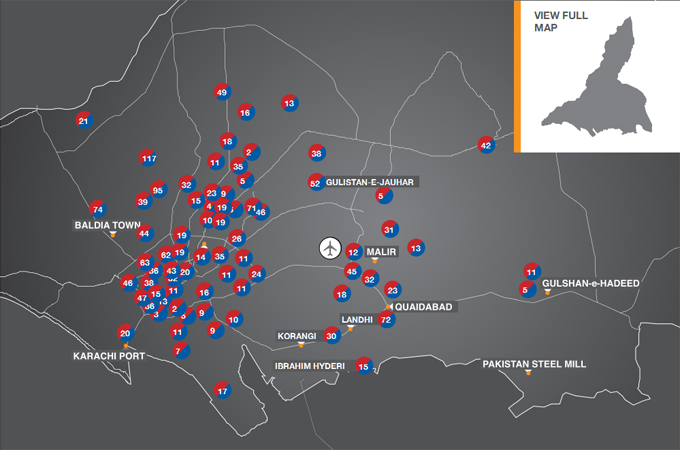Interactive: Karachi’s killing fields
Wracked by endemic political violence and crime, Karachi is the world’s most dangerous megacity.


Click on the image to launch the interactive
Karachi, a sprawling metropolis in Pakistan’s south, is one of the world’s largest cities. Estimates put the city’s population at more than 14 million (with some claiming it is as high as 20 million), putting it just outside the top 10 largest urban agglomerations in the world, according to the UN .
Keep reading
list of 4 itemsMapping Israel-Lebanon cross-border attacks
Eid Mubarak: Hear greetings in different languages
When is Eid al-Fitr 2024 and how is it celebrated?
Of the world’s 13 largest cities, Karachi is the most dangerous, according to data compiled by Al Jazeera.
Crime statistics gathered from governments, police departments and the UN show that Karachi has the highest homicide rate of the world’s 13 largest cities, coming in at 12.3 per 100,000 residents. Karachites often brush off the particularly violent nature of their city as being a byproduct of living in any major urban area in the developing world. But Karachi is exceptional; amongst megacities (with populations of more than 13 million), no other city’s homicide rate comes within 25 per cent of Karachi’s.
Karachi’s murder rate is comparable to the Brazilian city of Sao Paolo’s in the mid-2000s, when it was wracked with violence linked to organised crime and drugs, and was widely regarded as one of the most dangerous cities in the world. But Karachi’s story, a mix of crime (organised and otherwise) and political violence , remains largely unheard.
Exceptional in the region
| More on Karachi’s violence from Asad Hashim | ||||
|
Karachi’s violence is also exceptional in its region. Mumbai (in India) is often held up as an example of a sister-city to Karachi – a major South Asian urban area comprising more than 15 million residents, with endemic problems of governance, poverty and organised criminal gangs operating with links to locally influential political parties.
In 2011, there were 202 murders in Mumbai. In Karachi, there were 1,723.
Delhi (the Indian capital), the next closest major urban centre in South Asia had 543. In the first five months of 2012, there had already been 661 homicides in Karachi.
Haris Gazdar, the director of the Karachi-based Collective for Social Science Research, told Al Jazeera that this is because Karachi presents a hybrid case: in the porous boundary between criminal groups and mainstream political parties, it is similar to other South Asian cities, but it displays the same levels of violence as seen in many Latin American cities, where organised crime has long ravaged major cities.
“Karachi is a bit different – it’s a little bit like the Latin American cities, which have maybe half the population living in unplanned segments and they have their own systems [of service delivery]. Karachi is a bit different to South Asian cities [as well] in that it has a lot more violence,” he said.
“It has similar levels of violence as Latin American cities, but is different in that it has mainstream political parties who are also stakeholders, so in that way it’s a bit more South Asian.”
Finally, to put the numbers in perspective, consider this: in July and August last year, a period which saw a particular spike in political and violence based on land issues, there were 545 homicides in Karachi. That’s more than there were in the entire year in New York City (515).
How to use this interactive
This interactive illustrates homicide data for the years 2011 and 2012, broken down by police station, letting you explore a map of the city’s violence. Each red/blue circle represents a police station, and the number within it is the number of homicides which occurred within its remit. Click on the circle to see detailed data for each police district.
The default view shows you the city’s most dangerous districts. To get deeper into the data, click on the arrow in the top right corner. From there, you can explore the Detailed Homicide Data tab, which will show you all of the city’s police stations, as well as administrative and electoral maps of the city.
Of particular note is how homicides are clustered around certain areas in the city’s central and south zones – both key battlegrounds and strongholds for political parties and criminal gangs. The levels of violence in certain areas are staggering: the Pirabad police station, for example, registered 140 murder cases between January 1, 2011 and August 31, 2012 – that is more cases than were registered in the entire city of London, the capital of the United Kingdom, in 2011.
Pirabad is located in Orangi Town, a key site of contestation between the Muttahida Qaumi Movement (MQM) and the Awami National Party (ANP), as well an area where there is a high degree of activity in the informal land sector. Other notably dangerous districts, such as Orangi Town (116 homicides), Baldia Town (103) and Kala Kot (66) also correspond to sites of political contestation.
Much of Karachi’s violence is linked to political parties: click on the sliding menu at the bottom of the interactive to see homicide data broken down by political party.
Finally, this is a living document – it is currently updated with figures from January 1, 2011, to August 31, 2012, and will be continually updated to reflect the city’s ongoing bouts of political and other violence. All data is gathered through the Citizens-Police Liasion Committee (CPLC), a watchdog organisation that works closely with Karachi’s police and the provincial government.
Click here, or the image at the top of this article, to launch the interactive.
Follow Asad Hashim on Twitter: @AsadHashim
If you have trouble viewing the interactive, please upgrade your browser to the latest version available. This interactive has been optimised for viewing in Mozilla Firefox and Google Chrome.

